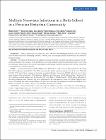| dc.contributor.author | WINDLE, HENRY | en |
| dc.date.accessioned | 2016-06-21T11:38:57Z | |
| dc.date.available | 2016-06-21T11:38:57Z | |
| dc.date.issued | 2014 | en |
| dc.date.submitted | 2014 | en |
| dc.identifier.citation | Saito M, Goel-Apaza S, Espetia S, Velasquez D, Cabrera L, Loli S, Crabtree JE, Black RE, Kosek M, Checkley W, Zimic M, Bern C, Cama V, Gilman RH; The Norovirus Working Group in Peru (Xiao L, Kelleher D, Windle HJ, van Doorn LJ, Varela M, Verastegui M, Calderon M, Alva A, Roman K), Multiple norovirus infections in a birth cohort in a Peruvian peri-urban community., Clin Infect Dis., 58, 4, 2014, 483 - 491 | en |
| dc.identifier.other | Y | en |
| dc.identifier.uri | http://hdl.handle.net/2262/76565 | |
| dc.description | PUBLISHED | en |
| dc.description.abstract | Human noroviruses are among the most common enteropathogens globally, and are a leading cause of infant diarrhea in developing countries. However, data measuring the impact of norovirus at the community level are sparse.
METHODS:
We followed a birth cohort of children to estimate norovirus infection and diarrhea incidence in a Peruvian community. Stool samples from diarrheal episodes and randomly selected nondiarrheal samples were tested by polymerase chain reaction for norovirus genogroup and genotype. Excretion duration and rotavirus coinfection were evaluated in a subset of episodes.
RESULTS:
Two hundred twenty and 189 children were followed to 1 and 2 years of age, respectively. By 1 year, 80% (95% confidence interval [CI], 75%-85%) experienced at least 1 norovirus infection and by 2 years, 71% (95% CI, 65%-77%) had at least 1 episode of norovirus-associated diarrhea. Genogroup II (GII) infections were 3 times more frequent than genogroup 1 (GI) infections. Eighteen genotypes were found; GII genotype 4 accounted for 41%. Median excretion duration was 34.5 days for GII vs 8.5 days for GI infection (P = .0006). Repeat infections by the same genogroup were common, but repeat infections by the same genotype were rare. Mean length-for-age z score at 12 months was lower among children with prior norovirus infection compared to uninfected children (coefficient: -0.33 [95% CI, -.65 to -.01]; P = .04); the effect persisted at 24 months.
CONCLUSIONS:
Norovirus infection occurs early in life and children experience serial infections with multiple genotypes, suggesting genotype-specific immunity. An effective vaccine would have a substantial impact on morbidity, but may need to target multiple genotypes. | en |
| dc.format.extent | 483 | en |
| dc.format.extent | 491 | en |
| dc.language.iso | en | en |
| dc.relation.ispartofseries | Clin Infect Dis. | en |
| dc.relation.ispartofseries | 58 | en |
| dc.relation.ispartofseries | 4 | en |
| dc.rights | Y | en |
| dc.subject | birth cohort | en |
| dc.subject | gastroenteritis | en |
| dc.subject | infant diarrhea | en |
| dc.subject | natural infection | en |
| dc.subject | norovirus | en |
| dc.title | Multiple norovirus infections in a birth cohort in a Peruvian peri-urban community. | en |
| dc.type | Journal Article | en |
| dc.type.supercollection | scholarly_publications | en |
| dc.type.supercollection | refereed_publications | en |
| dc.identifier.peoplefinderurl | http://people.tcd.ie/hjwindle | en |
| dc.identifier.rssinternalid | 89979 | en |
| dc.identifier.doi | 10.1093/cid/cit763 | en |
| dc.rights.ecaccessrights | openAccess | |
| dc.subject.TCDTheme | Cancer | en |
| dc.subject.TCDTheme | Immunology, Inflammation & Infection | en |
| dc.subject.TCDTheme | International Development | en |




